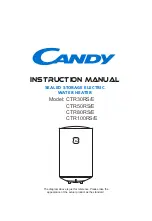
■
Some ppeople ccannot ssmell w
well. S
Some ppeople ccannot
smell tthe oodor oof tthe m
man-m
made cchemical aadded tto
propane oor nnatural ggas. YYou m
must ddetermine iif yyou ccan
smell tthe oodorant iin tthese ffuel ggases.
■
Learn to recognize the odor of propane gas and natural
gas. Local propane gas dealers and your local natural
gas supplier (utility) will be more than happy to give you
a “scratch and sniff” pamphlet. Use it to become
familiar with the fuel gas odor.
■
Smoking can decrease your ability to smell. Being
around an odor for a period of time can affect your
sensitivity to that particular odor. Odors present in
animal confinement buildings can mask fuel gas odor.
■
The oodorant iin ppropane ggas aand nnatural ggas iis ccolorless
and tthe iintensity oof iits oodor ccan ffade uunder ssome
circumstances.
■
If there is an underground leak, the movement of gas
through the soil can filter the odorant.
■
Propane gas odor may differ in intensity at different
levels. Since propane gas is heavier than air, there may
be more odor at lower levels.
■
Always bbe ssensitive tto tthe sslightest ggas oodor. If you
continue to detect any gas odor, no matter how small,
treat it as a serious leak. Immediately go into action as
discussed previously.
ATTENTION -- CRITICAL POINTS TO REMEMBER!
■
Propane gas and natural gas have a distinctive odor.
Learn to recognize these odors. (Reference “Fuel Gas
Odor” and “Odor Fading” sections above.
■
If you have not been properly trained in repair and service
of propane gas and natural gas fueled heaters, then do
not attempt to light heater, perform service or repairs, or
make any adjustments to the heater on propane gas or
natural gas fuel system.
■
Even if you are not properly trained in the service and
repair of the heater, ALWAYS be consciously aware of the
odors of propane gas and natural gas.
■
A periodic “sniff test” around the heater or at the
heater’s joints; i.e. hose, connections, etc., is a good
safety practice under any conditions. If you smell even a
small amount of gas, CONTACT YOUR FUEL GAS
SUPPLIER IMMEDIATELY. DO NOT WAIT!
Propane ggas aand nnatural ggas hhave m
man-m
made oodorants aadded sspecifically ffor ddetection oof ffuel ggas lleaks.
If aa ggas lleak ooccurs, yyou sshould bbe aable tto ssmell tthe ffuel ggas.
THAT’S YYOUR S
SIGNAL TTO G
GO IINTO IIMMEDIATE AACTION!
■
Do not take any action that could ignite the fuel gas. Do
not operate any electrical switches. Do not pull any
power supply or extension cords. Do not light matches
or any other source of flame. Do not use your telephone.
■
Get everyone out of the building and away from the area
immediately.
■
Close all propane gas tank or cylinder fuel supply valves,
or the main fuel supply valve located at the meter if you
use natural gas.
■
Propane gas is heavier than air and may settle in low
areas. When you have reason to suspect a propane
leak, keep out of all low areas.
■
Natural gas is lighter than air and can collect around
rafters or ceilings.
■
Use your neighbor’s phone and call your fuel gas
supplier and your fire department. Do not re-enter the
building or area.
■
Stay out of the building and away from the area until
declared safe by the firefighters and your fuel gas
supplier.
■
FINALLY, let the fuel gas service person and the
firefighters check for escaped gas. Have them air out
the building and area before you return. Properly trained
service people must repair the leak, check for further
leakages, and then relight the appliance for you.
WARNING
■
Do not use this heater for heating human living quarters.
■
Do not use in unventilated areas.
■
The flow of combustion and ventilation air must not be
obstructed.
■
Proper ventilation air must be provided to support the
combustion air requirements of the heater being used.
■
Refer to the specification section of the heater’s Owner’s
Manual, heater dataplate, or contact the L.B. White
Company to determine combustion air ventilation
requirements of the heater.
■
Lack of proper ventilation air will lead to improper
combustion.
■
Improper combustion can lead to carbon monoxide
poisoning in humans leading to serious injury or death.
Symptoms of carbon monoxide poisoning can include
headaches, dizziness and difficulty in breathing.
■
Symptoms of improper combustion affecting livestock
can be disease, lower feed conversion, or death.
Asphyxiation H
Hazard
5
Safety Precautions
FUEL GAS ODOR
ODOR FADING -- NO ODOR DETECTED






































